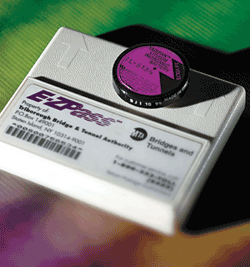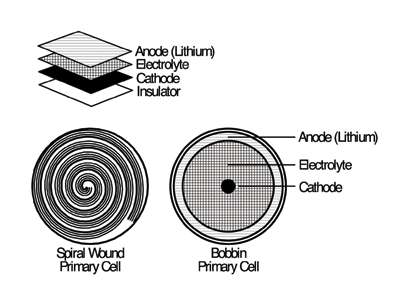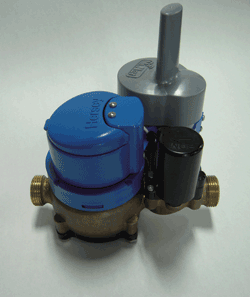Advanced lithium batteries power emerging RF technologies found in remote locations and challenging environments
BY SOL JACOBS
Vice President and GM,
Tadiran Batteries
www.tadiranbat.com
The global RF market remains vibrant, with rapid expansion into many vertical markets, including automatic ID and security, asset tracking, automatic toll collection systems, telemetry, oceanographic, animal research, SCADA, utility smart-grid metering, and more.
New applications are emerging continuously as RF communications converges with other technologies such as real-time locating systems (RTLS), Wi-Fi, and wireless sensor networks (WSN). Each successive generation of RF device uses smaller form factors yet demands increased power for greater product functionality, creating inherently contradictory design challenges for developing optimized power management solutions. These challenges are especially acute for remote applications where there is no access to the ac power grid, and where hostile environments hurt battery performance, potentially compromising data integrity and communication capabilities.
Remote applications typically require self-contained battery-powered management systems, with lithium thionyl chloride (LiSOCl2 ) batteries predominantly chosen due to proven long life in key RF applications such as automatic toll tags and automated meter-reading (AMR) devices.
Long life for automated toll tags
When millions of motorists flash their E-ZPass at toll booths each day, they are unaware that the RFID tag is powered by an LiSOCl2 battery capable of delivering years of safe, reliable, and trouble-free performance under the most challenging environmental conditions. LiSOCl2 batteries were chosen due to inherent long-life (self-discharge rate of less than 1% per year) as well as their ability to handle severe temperature cycles, as, according to SAE, a car’s windshield can reach 113°C, followed by rapid cool down. Conversely, in very cold weather, the battery must handle cold soak followed by a rapid temperature rise.

Fig. 1: The electronic toll tag is powered by LiSOClL2 .
LiSOCl2 batteries were also chosen for the first RFID tag for portable medical equipment that is capable of withstanding the high temperatures associated with autoclave sterilization cycles without requiring the battery to be removed. Use of an extended-temperature battery permits continuous 24/7 monitoring of the location and status of portable medical equipment throughout the hospital.
Powering a utility meter RF device
Virtually all leading AMR/AMI water meter manufacturers specify LiSOCl2 batteries, which offer the highest specific energy (energy per unit weight) and energy density (energy per unit volume) of all existing battery chemistries. One reason for the high energy density is the large electric potential of lithium, which exceeds that of other metals, and which produces the high voltages typical of lithium batteries (2.7 to 3.9 Vdc). Lithium cells also use a nonaqueous electrolyte, which enables certain lithium batteries to operate in extreme temperatures (55° to 125°C).
LiSOCl2 cells are constructed two ways: bobbin-type and spiral-wound. Bobbin cells consist of an outer cylinder made of lithium metal and an inner electrode that is reminiscent of a bobbin of thread. Spiral-wound cells use flat sheets of metal wound around a core, providing a large surface area that can create high currents. The greater number of layers within the spiral-wound cell reduces the volume of electrolyte these batteries can hold, whereas bobbin cells can hold more electrolyte, enabling them to deliver about 30% more energy than spiral cells of equivalent size.

Fig. 2: Comparison of bobbin-type and spiral wound cells.
In 1984, Aclara (formerly Hexagram) began powering its first RF-networked AMR meters with bobbin cells. Today, millions of these units remain in operation, the earliest of which are still operating on their original LiSOCl2 battery after 28 years in the field. This proven track record allows today’s AMR/AMI equipment manufacturers to offer longer-term performance contracts that increase the long-term ROI while enhancing customer service, increasing billing accuracy, improving leak detection, and permitting continuous monitoring of usage and demand.
Batteries for high-current pulse applications
RF devices are becoming increasingly complex and feature-rich, exemplified by “on-demand” two-way RF communications that require high-current pulses for data gathering and transmission. To support high-current pulse applications, Tadiran developed the PulsesPlus battery, which combines a standard bobbin-type LiSOCl2 battery with a patented Hybrid Layer Capacitor. This combination allows a remote wireless device to operate continuously with low background current, periodically draw high-current pulses for data capture and transmission, then return to a low current “sleep” or “standby” state.
The PulsesPlus battery also features a unique voltage curve that allows devices to be programmed to offer low battery status alerts, including a 3.6-V system that indicates when 95% of battery capacity has been exhausted, and a 3.9-V system that indicates when 90% of available battery capacity has been used up.
The value of an end-of-life indication can be enormous. For example, the Water and Sewer Commission of Springfield, MA, installed 44,000 AMR meters, then, after just a few years of operation, found it necessary to begin replacing 4,000 batteries each year at a total projected cost of $9.2 million. Concerned that their labor force would be overwhelmed by a rapid, system-wide battery failure, the water commissioners chose to start replacing perfectly good batteries simply to avoid the potential chaos of a widescale battery failure. Had PulsesPlus batteries been used and the meters programmed to offer low-battery status alerts, such a premature battery replacement program could have been avoided.
Supporting long-term two-way RF communications
An excellent case study involves Mueller Systems’ Mi.Net Infrastructure Network, which allows water utilities to link meters, distribution sites, and control devices into an integrated and scalable data network.
A key component of the Mi.Net System is the Mi.Node water meter interface unit, which provides full, two-way communications between the Mi.Net System’s Mesh/Fixed AMI system and the smart meter. Data from the meters are temporarily stored within Mi.Node’s internal memory, then transmitted “on-demand” or at specified intervals via an unlicenced radio frequency channel to a Mi.Gate collector, which relays the data to the Mi.Net System’s host server.

Fig. 3: Mueller Systems’ Mi.Node water meter interface units provide a direct connection to all Hersey water meters equipped with a patented Translator encoder register. The MiNode interface unit provides automatic notification of low battery status and the battery pack can be accessed independently for preemptive maintenance.
Mi.Node interface units are often installed in underground pits, requiring multiple moisture barriers to provide a watertight solution. Robust product construction, combined with Tadiran’s proven 20+ year technology, enables Mueller Systems to offer a 20-year product warranty.
PulsesPlus batteries handle the periodic high-current pulses required for “on-demand” two-way communications, allowing Mi.Node interface units to track hourly water consumption, identify potential tampering, and provide automatic notification, including e-mail alerts, if excessive usage or potential leaks are detected. If a pipe bursts or a faucet or toilet leaks excessively, the customer is alerted automatically, thus reducing monthly water bills and conserving valuable water resources.
Mi.Node interface units also provide automatic notification of low battery status, enabling scheduled battery replacements that can extend the operational life of the Mi.Net System well beyond the 20-year warranty period, which makes an AMR/AMI network installation an even more attractive investment.
Another key benefit is enhanced employee safety. Instead of having to collect meter readings by entering harsh environments such as basements or subterranean meter boxes, utility employees can use Mi.Net to collect meter readings from the safety and comfort of their office or by driving in close proximity to meters. Also, in the event of a service disconnect or reconnect, two-way “on-demand” communications allows customer service and accounting personnel to handle the entire process remotely, thus protecting employees in the field from potentially hostile encounters with customers.
These examples demonstrate how ongoing enhancements to lithium chemistries and battery manufacturing are addressing the increasingly sophisticated power requirements of emerging RF technologies. ■
Advertisement
Learn more about Tadiran





